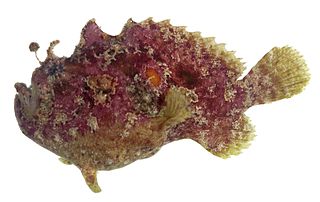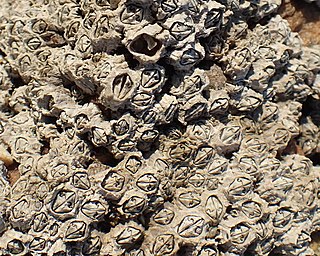Realized niche width, is a phrase relating to ecology, is defined by the actual space that an organism inhabits and the resources it can access as a result of limiting pressures from other species.

Intertidal ecology is the study of intertidal ecosystems, where organisms live between the low and high tide lines. At low tide, the intertidal is exposed whereas at high tide, the intertidal is underwater. Intertidal ecologists therefore study the interactions between intertidal organisms and their environment, as well as between different species of intertidal organisms within a particular intertidal community. The most important environmental and species interactions may vary based on the type of intertidal community being studied, the broadest of classifications being based on substrates—rocky shore and soft bottom communities.

Austrominius modestus is a species of barnacle in the family Elminiidae, native to Australia, Tasmania and New Zealand, but now spread to Britain and the north west coasts of Europe. It reaches a maximum size of about 10 millimetres in diameter.

The Chthamalidae are a family of chthamaloid barnacles, living entirely in intertidal/subtidal habitats, characterized by a primary shell wall of eight, six, or four plates, lacking imbricating plate whorls, and either membraneous or more rarely calcareous basis. They are not found below immediate subtidal habitats, and more likely are found in the highest tier of shallow-water barnacle fauna. They can be found in the most rigorous wave-washed locations, and some species are found in the surf zone above high tide mark, only receiving water from wave action at high tide.

Acorn barnacle and acorn shell are vernacular names for certain types of stalkless barnacles, generally excluding stalked or gooseneck barnacles. As adults they are typically cone-shaped, symmetrical, and attached to rocks or other fixed objects in the ocean. Members of the barnacle order Balanomorpha are often called acorn barnacles.

Semibalanus balanoides is a common and widespread boreo-arctic species of acorn barnacle. It is common on rocks and other substrates in the intertidal zone of north-western Europe and both coasts of North America.

Chthamalus is a genus of barnacles that is found along almost all non-boreal coasts of the northern hemisphere, as well as many regions in the southern hemisphere. These small barnacles have been studied in part because of the taxonomic confusion over a group of species that, by and large, are morphologically and ecologically quite similar. In recent years, molecular techniques have identified a number of cryptic species that have been subsequently confirmed by taxonomists using morphological measurements. Most recently the genus has been shown to be paraphyletic, with the genus Microeuraphia nested within Chthamalus.

Chthamalus stellatus, common name Poli's stellate barnacle, is a species of acorn barnacle common on rocky shores in South West England, Ireland, and Southern Europe. It is named after Giuseppe Saverio Poli.

Chthamalus montagui, common name Montagu's stellate barnacle, is a species of acorn barnacle common on rocky shores in South West England, Ireland, and Southern Europe.

Patella ferruginea, commonly known as the ribbed Mediterranean limpet, is a species of sea snail, a true limpet, a marine gastropod mollusk in the family Patellidae, one of the families of true limpets. It is a large limpet, native to the western Mediterranean Sea, and although common in the past, it is now rare and restricted to only a few locations.

Montagu's blenny, also known as the capuchin blenny, is a species of combtooth blenny found in the intertidal zones of the eastern Atlantic ocean from England to Madeira and the Canary Islands as well the Mediterranean Sea, the Black Sea and the Sea of Marmara. This species prefers rocky shores with much wave action. This species grows to a length of 7.6 centimetres (3.0 in) SL. It is the only species in the genus Coryphoblennius.
Hemioniscus balani, a species of isopod crustacean, is a widespread parasitic castrator of barnacle in the northern Atlantic Ocean. Its range extends from Norway to the Atlantic coast of France, and as far west as Massachusetts. It is also commonly found on the Pacific coast of North America; it is not known if the Pacific and Atlantic populations are the same species, or if the Pacific population exists following human-assisted introduction.
Chthamalus anisopoma is a species of intertidal barnacle. Indigenous to the northern Gulf of California, adult Chthamalus anisopoma are found on exposed shores between 0.0 and 2.0 m above mean low tide. The species is typically absent in areas protected from wave splash. Notably, Chthamalus anisipoma exhibits predator-mediated plasticity in the growth of its calcareous test. In the presence of the carnivorous gastropod Acanthina angelica, the barnacle's typical conical growth form is altered to appear bent over, with the operculum perpendicular to the substrate. The alternate form is more resistant to predation.

Chamaesipho brunnea is an intertidal barnacle common in New Zealand, in both the North Island and the South Island. Juveniles have six shell wall plates, reducing to four in adults, and with age, all plates become concrescent, with no trace of sutures inside or out. Shell is brown colored. The related, and sometimes associated Chamaesipho columna is much smaller in size, by nearly half, while Elminius, which can associate with both species, also has four shell wall plates, but plates remain distinct at all stages. The shell of C. columna corrodes to a pitted surface, while that of C. brunnea has a lamellar corrosion.
The barnacle genus Nesochthamalus was erected by Foster & Newman, 1987, to include sole species Chthamalus intertextus originally named by Darwin in 1854. It is widespread on islands in Western Pacific Ocean, including Hawaii, and presents combinations of unusual features which make easily recognizable for field workers. These include dirty white shell exterior with deep purple colored interior, operculars colored purple. Opercular plates on each side calcify together in all but youngest individuals, and cannot be separated or easily distinguished from each other. This feature is shared only by Rehderella belyaevi, but in latter species, scutum and tergum can be distinguished by raised ridge replacing old articular margin. Unique feature of Nesochthamalus is its basis. In young individuals, it is entirely membraneous, and with age, becomes secondarily calcareous progressively inwards, leaving only the center membraneous. As the basis calcifies, it rises off the substrate forming a saucer shape when viewed from the side. In addition, interior of shell is secondarily calcified.

Chthamalus fragilis is a small gray barnacle found in the upper intertidal zone of the northwestern Atlantic Ocean, from approximately Cape Cod southward to Florida and into the Caribbean and Gulf of Mexico. It is also commonly known as little grey barnacle. The species is believed to have been distributed only as far northward as North Carolina or Virginia until the late 1800s, when it was noticed along the Massachusetts coast. The species may have expanded its range naturally or been introduced to New England through anthropogenic activities. Chthamalus fragilis is unusual in that it often recruits to stems of Spartina alterniflora.

Antennatus coccineus, the scarlet or freckled frogfish, is a species of frogfish originally classified as Chironectes coccineus and Antennarius coccineus. It lives within tropical waters and has a central distribution being around Indo-East-Pacific areas- excluding Hawaii. The habitat of the scarlet frogfish is in the shallow zones of the ocean. It is found within reef areas, in rocky mounds or sponges where there are places for it to hide amongst from predators. The scarlet frogfish comes in a variety of colours, from tan and brown colours to bright reds and yellows and will grow to a maximum length of 13 centimetres (5.1 in). It can be identified taxonomically through its pectoral rays, the presence of dark patches that appear on its fins and body, along with its lack of distinctive tail base. The scarlet frogfish is not harmful to humans and is not caught by fisheries for consumption purposes, however it has been caught previously for studies relating to the abundance of reef-dwelling fish and as bycatch of shrimp trawling. Similar to other frogfish species, the scarlet frogfish is a predatory carnivore and exhibits a low degree of sociality, only interacting with other scarlet frogfish during their mating period.

Tesseropora rosea, the rose barnacle is a species of barnacle found in eastern and southern Australia, and South Africa.

Chthamalus dalli, the little brown barnacle, is a species of barnacle in the family Chthamalidae. It can be found in intertidal zones along the North American Pacific coast from Alaska to San Diego.

Chthamalus dentatus, the tooth barnacle, is a species of star barnacle in the family Chthamalidae.














